The Intel Core i3-7350K (60W) Review: Almost a Core i7-2600K
by Ian Cutress on February 3, 2017 8:00 AM ESTProfessional Performance: Windows
Agisoft Photoscan – 2D to 3D Image Manipulation: link
Agisoft Photoscan creates 3D models from 2D images, a process which is very computationally expensive. The algorithm is split into four distinct phases, and different phases of the model reconstruction require either fast memory, fast IPC, more cores, or even OpenCL compute devices to hand. Agisoft supplied us with a special version of the software to script the process, where we take 50 images of a stately home and convert it into a medium quality model. This benchmark typically takes around 15-20 minutes on a high-end PC on the CPU alone, with GPUs reducing the time.
Here we report the overall time to complete the test – sub-test results can be found in Bench.
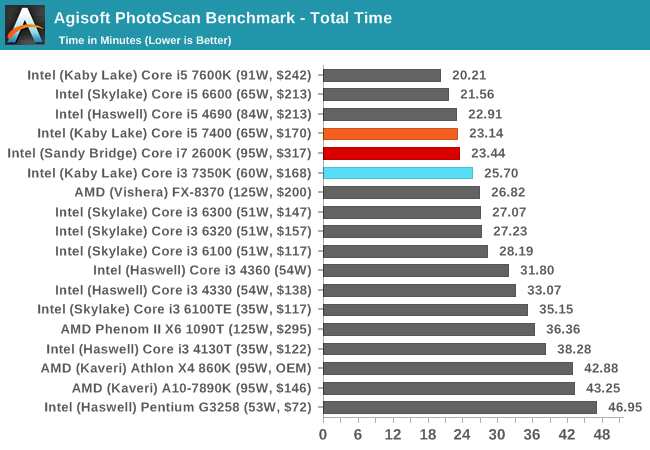
Photoscan is a mix of single and multi-threaded segments, but overall the extra cores in the i5/i7 beat the Core i3, but not by much.
Cinebench R15
Cinebench is a benchmark based around Cinema 4D, and is fairly well known among enthusiasts for stressing the CPU for a provided workload. Results are given as a score, where higher is better.
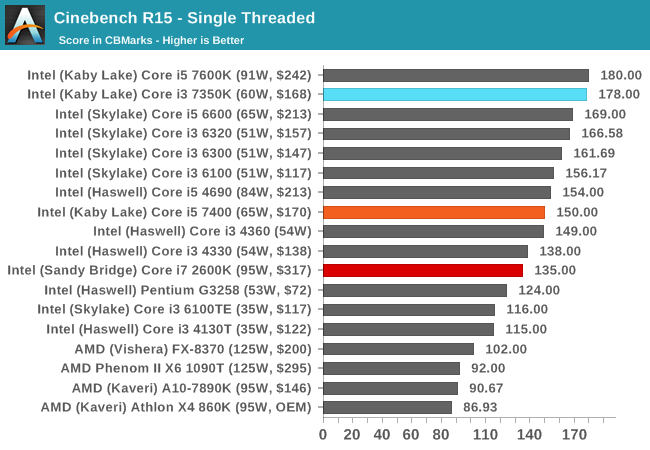
All the Kaby Lake processors seem to do well in CB15 single threaded performance, given that all the K-processors can reach 4.2 GHz or higher one way or another. Nonetheless, the age of the Core i7-2600K is showing here.
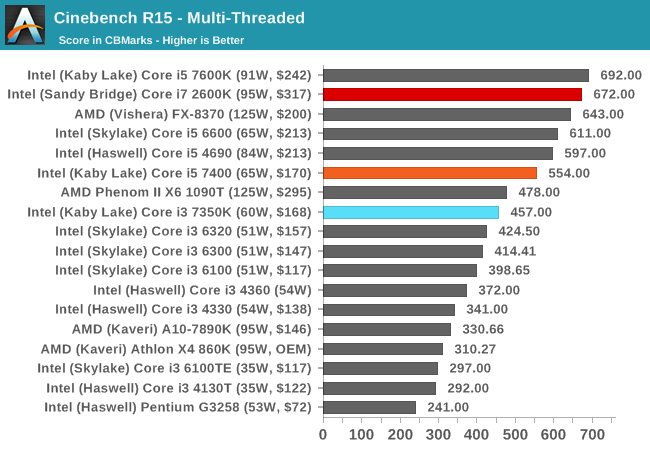
Turning the tables with actual cores, and the Core i7-2600K gets a significant leg up here. The Core i5 also sits above the Core i3.
HandBrake v0.9.9: link
For HandBrake, we take two videos (a 2h20 640x266 DVD rip and a 10min double UHD 3840x4320 animation short) and convert them to x264 format in an MP4 container. Results are given in terms of the frames per second processed, and HandBrake uses as many threads as possible.
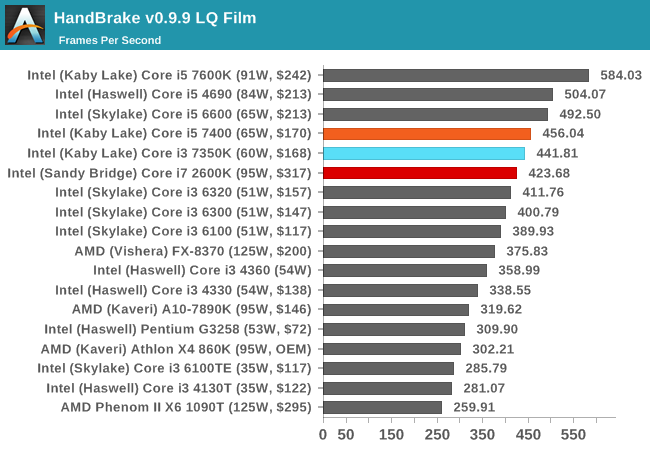

For video conversion, having small frames puts all three CPUs in a similar spot. But ramp up the frame size and we see the Kaby Lake i5 pull ahead due to IPC and instructions. The Core i3 has enough oomph to match the extra threads on the Core i7-2600K though.
Hybrid x265
Hybrid is a new benchmark, where we take a 4K 1500 frame video and convert it into an x265 format without audio. Results are given in frames per second.
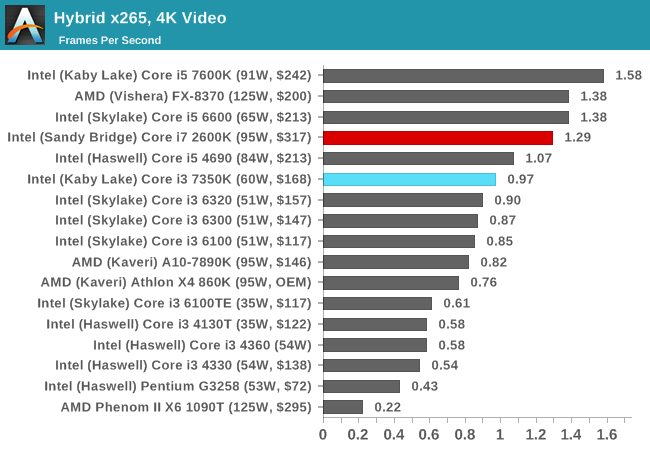
With a different video conversion tool and render, the extra cores and threads of the Core i7 is more than enough to give it a 30% advantage over the Core i3-7350K. It makes me wonder if another +30% frequency would help the Core i3.










186 Comments
View All Comments
TheinsanegamerN - Friday, February 3, 2017 - link
This chip is 6 years late. Back when sandy bridge was the newest chip, a dual core i3 was a super relevant choice for gaming, a quad core was overkill.Today, for gaming builds, a i5 chip is almost always a better choice, unless you only play games that are single threaded. And the i3 is more power hungry then locked quad cores.
At $130, this would be a great choice, but ATM, the i3k is overpriced for what it offers for a modern system.
nathanddrews - Friday, February 3, 2017 - link
I'd argue that with the introduction of this i3 K-variant and the new hyperthreaded Pentium, Intel just gave a lot of people a reason to not by an i5. The message from Intel seems to be this:"If you need great single-threaded performance with some mild multi-threaded, get the Pentium or i3. If you need great multi-threaded performance with great single-threaded, get an i7."
I'd say they are preemptively stacking the product deck prior to the release of AMD Ryzen - offering entry-level gamers more options without diluting their HEDT status.
BedfordTim - Friday, February 3, 2017 - link
In many of the games an i3-6100 offers effectively the same performance and is $50 cheaper. It isn't a case of the i-3750k offering great performance, so much as the games are not CPU limited. This points towards an even more expensive graphics card and the even cheaper CPU.jayfang - Friday, February 3, 2017 - link
Agree. Whatever about actual performance, it seems quite clear the cool factor of "unlocked" Ryzen's and joining the "overclocking community" is getting a pre-emptive strike from Intel.Michael Bay - Saturday, February 4, 2017 - link
OC never had a "cool factor".eldakka - Sunday, February 5, 2017 - link
In the late 90's into the early 00's, when people would travel for hours carting their PC to a LAN gaming event with 100's (or even thousands) of other people, having an OC'ed machine was indeed cool amongst that Geek crowd./em remembers his dual celeron 300A's OC'ed to 450MHz (yes, that's Mega - not Giga - hertz).
drgoodie - Tuesday, February 7, 2017 - link
I had a dual 366Mhz Celeron box OC'd to 550Mhz. It was cool back then.dsraa - Tuesday, February 14, 2017 - link
It was indeed and still is very very cool......I had been OC'ing my systems way back to the original Pentium 100, and then got a Celeron 300, OMG those were the days....If you don't think its cool, what the hell are you doing on Anandtech??!??!!!?DLimmer - Wednesday, February 15, 2017 - link
You may have missed the joke. This was a play on words; Overclocking produces more heat so it's "not cool."DLimmer - Wednesday, February 15, 2017 - link
OC is "hot, hot, hot"!